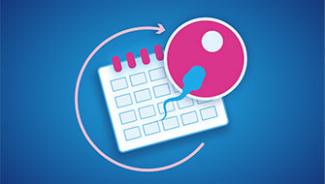Pelvic floor 101: Understanding the basics

The pelvic floor performs essential functions in your body—but you may not have learned much about it in school. If you have some questions about your pelvic floor and how it works, you're not alone. It's important to know what your pelvic floor is, what can affect it and how you can protect it.
A weak pelvic floor can cause some annoying problems, but there are things you can do (starting today!) to strengthen it. And if you’re pregnant or thinking about pregnancy in the future, research has shown that prenatal pelvic floor education is key to reducing the risk of birth-related pelvic floor trauma, and even mitigating the distress it can cause if it does occur.1 So let’s get started.
What is the pelvic floor ?
The pelvic floor is a thin, sling-like sheet of muscle fibers and connective tissue holding the pelvic organs in place.2,3 Pelvic organs include the bladder, urethra, intestines, rectum, uterus, cervix and vagina.3
What does my pelvic floor do for me ?
Your pelvic floor supports, protects and controls. Have you ever coughed or sneezed and felt a little pee leak out ? A weak pelvic floor could be to blame. According to the International Urogynecological Association (IUGA), when you cough, sneeze or strain, the muscles in a strong pelvic floor contract, which helps prevent urine leakage.3
Your pelvic floor also protects your pelvic organs, holds your pelvic organs in the correct position and supports the organs in your abdomen.3 When you pee, poop or pass gas, your pelvic floor helps control these functions.3 Your pelvic floor also plays an important role during sex: If you’re better able to contract and relax your pelvic floor, it’s more likely that vaginal sex will be pain-free, you’ll see an increase in vaginal lubrication and you may experience better orgasms, thanks to increased blood flow.4
What can affect the pelvic floor ?
According to the National Institutes of Health, while many different risk factors for pelvic floor disorders (PFDs) are currently being studied, more research is needed. Factors being researched for their potential impact on pelvic floor health and function include :
- Pregnancy and childbirth : For first-time parents, a 2018 study in the Journal of the American Medical Association showed a strong connection between pelvic floor disorders and how the baby was delivered. The nine-year study showed that people who delivered by cesarean had about half the risk of developing PFDs compared to those who had spontaneous vaginal births.5 Having more than one child, or having a baby vaginally with the aid of instruments ( like forceps) or devices ( like a vacuum) during vaginal birth, are also being considered as possible links to PFDs.6
-
Pressure: Studies have shown that increased pressure can also be a cause of PFDs. If you’re frequently constipated and often strain when using the bathroom, this can increase pressure on your pelvic floor.6 Diet can contribute to that pressure — too little fiber or water can lead to hard or irregular bowel movements, while too many processed foods in your diet can lead to constipation.7 Increased pressure can also come from heavy lifting, chronic coughing or obesity.6,7
-
Age: Your pelvic floor muscles can weaken as you get older, especially during perimenopause and menopause. This may be due to the decrease in estrogen that occurs during perimenopause and menopause.4,6
-
Genes: Some people simply have stronger bones, muscles and connective tissues than others. Additionally, if you have a condition that affects the strength of your connective tissues (typically genetic or autoimmune in nature), this will affect the strength of your pelvic floor as well.6
-
Surgery or injury: If you’ve had a hysterectomy or surgery to correct pelvic organ prolapse (a condition where at least one pelvic organ drops from the normal position8) in the past, you are at a higher risk for future PFDs. You’re also at a higher risk for pelvic organ prolapse if your pelvic floor is injured during a fall, for example, or in a car accident.7
The pelvic floor in pregnancy : What you need to know about potential injuries
According to IUGA, damage to the pelvic floor’s muscles, tissues or nerves during pregnancy or childbirth can result in something doctors call “maternal pelvic floor trauma.” IUGA defines three types of injuries that can happen:
-
Mechanical injury: often involves the head of the fetus interfering with the pelvic floor, or forceps being used during delivery.
-
Nerve injury: often involves compression or damage to the main nerve to the pelvic floor, generally caused by the fetus’s head, the size of a large baby, prolonged second-stage labor or the use of forceps during delivery.
-
Indirect injury: often involves hormonal changes during pregnancy.9
Maternal pelvic floor trauma can result in urinary, bowel and sexual problems, and symptoms of prolapse. If you’re concerned about being at risk for pelvic floor dysfunction, make sure to talk to your doctor about them early. They can help you understand your pelvic floor health and address your concerns.
The importance of pelvic floor exercises in pregnancy — and throughout your life
The National Association for Continence (NAFC) recommends pelvic floor exercises to strengthen your pelvic floor. Considering that both pregnancy and high-impact activity are considered risk factors for pelvic floor disorders, one recent study looked at the impact of pregnant women regularly participating in high-and low-impact aerobics while also incorporating pelvic floor muscle exercises into their routine. The study concluded that pelvic floor exercises should be recommended for women who are pregnant, especially those who regularly engage in high- and low-impact aerobics.10
While especially important for those who are pregnant or planning for pregnancy, NAFC says these exercises will help you keep your pelvic floor strong as you age regardless of pregnancy.11 If you're pregnant, it's important to talk to your healthcare provider about whether pelvic floor exercises are appropriate for you, and if so, which ones you might want to consider.
Just like you care for other parts of your body, it's necessary to be mindful of your pelvic floor.Taking care to include plenty of fiber in your diet and stay hydrated — and doing a few simple exercises — can go a long way toward saving you trouble down the road. And if you're worried something's amiss, don't be shy about talking to your doctor. Even though you may not remember learning about your pelvic floor in health class, it's important — as is taking care of it.
Related blog articles
Sources :
- Johnson KT, Williams PG, Hill AJ. The importance of information: prenatal education surrounding birth-related pelvic floor trauma mitigates symptom-related distress. Journal of Women's Health Physical Therapy. 2022;46(2):62-72. doi: 10.1097/JWH.0000000000000229. Accessed January 17, 2023. https://journals.lww.com/jwhpt/Fulltext/2022/04000/The_Importance_of_Information__Prenatal_Education.2.aspx
-
International Urogynecological Association. Pelvic floor exercises. Accessed January 17, 2023. https://www.yourpelvicfloor.org/conditions/pelvic-floor-exercises/
-
Eunice Kennedy Shriver National Institute of Child Health and Human Development, National Institutes of Health. About pelvic floor disorders (PFDs). Updated January 8, 2020. Accessed January 17, 2023. https://www.nichd.nih.gov/health/topics/pelvicfloor/conditioninfo
-
National Association for Continence. Sex and your pelvic floor. Accessed January 17, 2023. https://nafc.org/bhealth-blog/sex-and-your-pelvic-floor/
-
Blomquist JL, Muñoz A, Carroll M, Handa VL. Association of delivery mode with pelvic floor disorders after childbirth. JAMA. 2018;320(23):2438–2447. doi: 10.1001/jama.2018.18315. Accessed January 17, 2023.https://jamanetwork.com/journals/jama/fullarticle/2718794
-
Eunice Kennedy Shriver National Institute of Child Health and Human Development, National Institutes of Health. What causes pelvic floor disorders (PFDs)? Updated January 8, 2020. Accessed January 17, 2023. https://www.nichd.nih.gov/health/topics/pelvicfloor/conditioninfo/causes
-
American Urogynecologic Society. What are PFDs? Accessed January 17, 2023. https://www.voicesforpfd.org/about/what-are-pfds/
-
U.S. Food & Drug Administration. Pelvic organ prolapse (POP). Updated April 16, 2019. Accessed January 17, 2023. https://www.fda.gov/medical-devices/urogynecologic-surgical-mesh-implants/pelvic-organ-prolapse-pop
-
International Urogynecological Association. Maternal pelvic floor trauma. Accessed January 17, 2023. https://www.yourpelvicfloor.org/conditions/maternal-pelvic-floor-trauma/
-
Szumilewicz A, Dornowski M, Piernicka M, et al. High-low impact exercise program including pelvic floor muscle exercises improves pelvic floor muscle function in healthy pregnant women — a randomized control trial. Front Physiol. 2019;9:1867. doi: 10.3389/fphys.2018.01867. Accessed January 17, 2023. https://www.frontiersin.org/articles/10.3389/fphys.2018.01867/full
-
National Association for Continence. 4 moves to strengthen your pelvic floor before getting pregnant. Accessed January 17, 2023. https://nafc.org/bhealth-blog/4-moves-to-strengthen-your-pelvic-floor-before-getting-pregnant/

When is the best time to get pregnant?
There are only a few days each cycle, around ovulation, when a woman is fertile. Knowing these days can maximise your chance of conceiving.

Can I get pregnant if I'm over 35?
If you’re over 35 you may need a little more patience and greater understanding about your fertility window to help you have a baby naturally.




